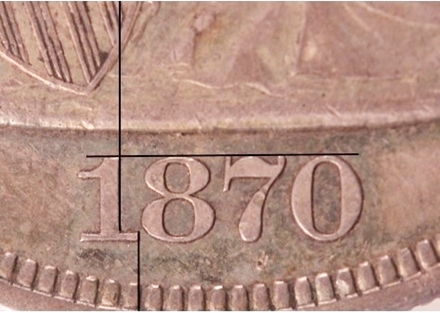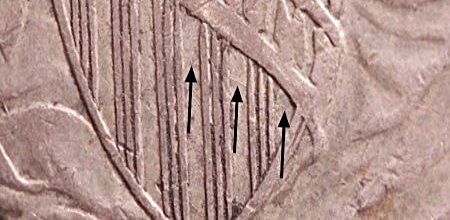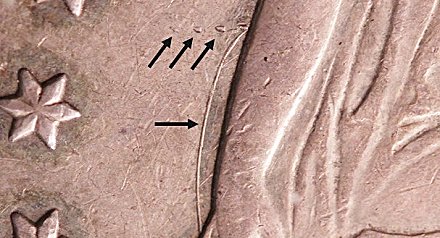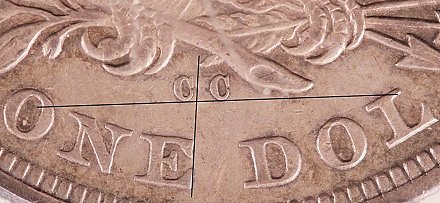|
|
Comments: This is the first of three uses of Obverse 3 and the only use of Reverse C in 1870. Reverse C was subsequently used to strike all 1871-CC examples. |
Obverse 3 The following photo shows the Obverse 3 attribution grid. The date position is virtually identical to obverse 1. The only slight difference is the date grid. The right base of the 1 is RE on Obverse 1, JL of RE on Obverse 3  1870-CC Obverse 3 attribution grid Obverse 3 is similar to Obverse 1, but exhibits few markers that allow easy identification (obverse die state a, seen only on this die marriage and described further below, is an exception, with major die markers). The most obvious features are the LACK of any of the markers described for obverse 1. In addition there is a light die line in the shield that can be noted on mid- to high-grade examples. This feature is shown on the next photo.  1870-CC Obverse 3 die line in shield recesses The line is very light, but still visible in the picture. It arcs across shield recesses 5, 6, and 7, extending to the border of the shield. It should be visible under medium to high magnification, 10-power or more, for coins grading XF40 or higher. It will be difficult to see on lower grades. In its perfect state, seen only on OC-4, Obverse 3 exhibits several notable markers. The following photo shows these markers, in the field left of Miss Liberty’s arm. Note the four segments at the top of the area pictured and the curving die line which parallels Miss Liberty’s arm. This damage in the field was apparently quickly noted by mint officials and removed by polishing the die. OC-4 is the rarest of the 1870-CC die marriages, with a rarity rating of R7-. Only 5 examples have been confirmed by the authors (as of February, 2019).  1870-CC Obverse 3 die markers in left field near hand
In obverse die state b the die has been polished, removing evidence of the die lines and segments. In state a Obverse 3 shows a significant unfinished area under the chin. In state b the area under the chin is now mostly finished, confirming that the state with die lines represents the earliest die state. The early state die markers are seen only on OC-4. The OC-4 die marriage has never been seen without these markers. Obverse 3 was used later to strike die marriages OC-5 and OC-6. These die marriages have been seen only with obverse die state b. |
The following photo shows the attribution lines for 1870-CC Reverse C.  1870-CC Reverse C attribution lines Reverse C is the second of two wide CC reverses, A and C. The wide CC’s can be identified by noting that a line from the tip of the arrow feather to the upper right edge of the E in ONE passes completely right of the first C. Reverse C can be distinguished by noting the line drawn under the mintmark. On Reverse A this line grazes the top of the O in ONE and barely touches the lower tip of the upper left serif of the L in DOL. On Reverse C this line passes through the right side of the curve of the O and upper right serif of the L. Reverse C is rare and seldom seen. It is found only on this die marriage. OC-4 is by far the rarest of the 1870-CC die marriages. Only 5 examples are currently known.
|
| Photo credits:
Obverse 3 and Reverse C: 1870-CC PCGS AU53, from the Osburn-Cushing reference collection. |
